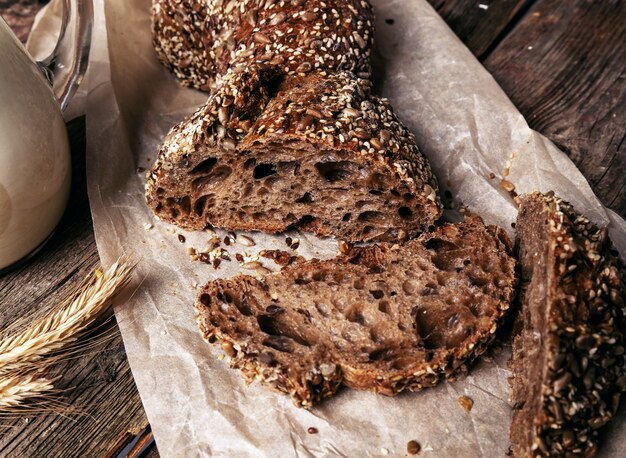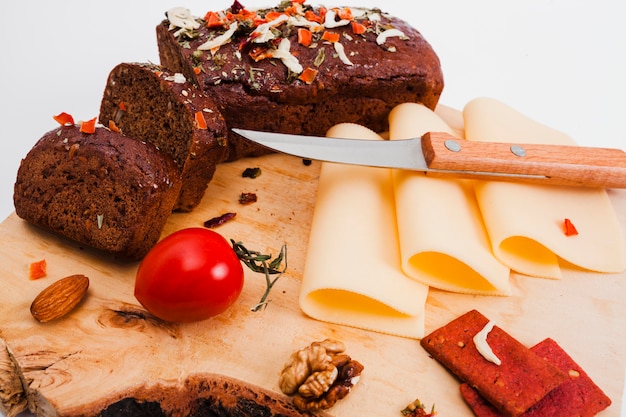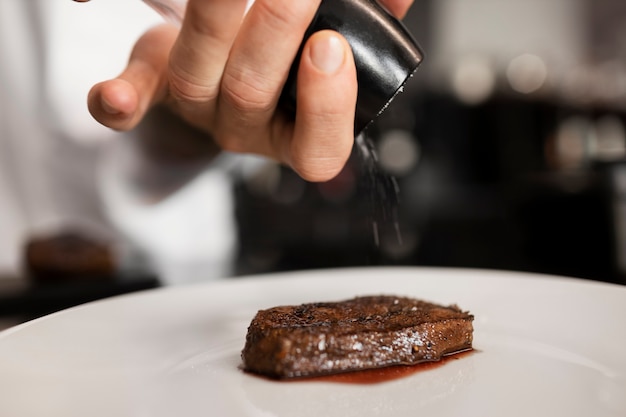Ah, meatloaf. The humble, comforting dish that brings back memories of family dinners and hearty meals. But let's be honest, cooking a meatloaf that's perfectly moist, flavorful, and cooked through can be a bit of a culinary puzzle. One of the biggest questions that pops up is: what temperature should I cook it at? I've been there, trying to decipher the oven's mysteries and hoping for the best. But fear not! This guide is here to guide you through the ins and outs of meatloaf cooking temperatures, sharing my own experiences and tricks along the way.
(Part 1) The Basics: Why Temperature Matters

Think of cooking a meatloaf like a delicate dance between heat and time. You want to give it enough heat to cook through properly, but too much, and you'll end up with a dry, crumbly mess. It's a bit like baking a cake, where you don't want the outside to burn before the center is cooked through. That's where the right temperature comes in. It's not just about hitting a target number; it's about controlling the rate of cooking and ensuring the inside reaches a safe temperature without the outside turning into a charcoal briquette.
The Importance of internal temperature
The golden rule for meatloaf, or any meat for that matter, is to ensure it reaches a safe internal temperature. For meatloaf, we're aiming for 160°F (71°C). Why? Well, this temperature is enough to kill off any harmful bacteria lurking in the meat. This is especially important for ground meat, which is more susceptible to contamination.
Now, you might be thinking, "How do I know if it's reached that temperature?" This is where your trusty meat thermometer comes in. It's a kitchen essential that every home cook should have. Simply insert it into the thickest part of the meatloaf, making sure it doesn't touch any bones, and check the reading. If it reaches 160°F (71°C), you're good to go!
Temperature Zones: Understanding the Oven
Now, when it comes to ovens, they're not all created equal. Some ovens might run hotter or colder than others. Even the same oven can have different hot spots depending on where you place the meatloaf. That's why using an oven thermometer is a brilliant idea. It'll give you a more accurate reading of the actual temperature inside your oven. You'll be able to adjust your cooking time and temperature accordingly.
(Part 2) Getting Down to Business: Ideal Meatloaf Cooking Temperatures

So, what's the magic number for cooking meatloaf? The good news is, it's pretty straightforward. For a standard meatloaf, aim for a cooking temperature of 350°F (175°C). This temperature strikes a beautiful balance: hot enough to cook the meatloaf through, but gentle enough to avoid overcooking it. You'll want to stick to this temperature for the entire cooking time. Don't be tempted to crank up the heat in the last few minutes. You'll end up with a burnt crust and a raw centre. Trust me, I've been there.
Why does this temperature work so well? Well, it allows the meatloaf to cook evenly, ensuring that the center is cooked through without the outside getting too brown. The slower cooking process also helps to prevent the meat from drying out.
meatloaf size Matters
Here's where things get a bit trickier. The size of your meatloaf will influence the cooking time, and therefore, how long you need to maintain the oven temperature. For a smaller meatloaf, around 1 to 1.5 pounds, you'll be looking at a cooking time of around 45 to 60 minutes. For a larger meatloaf, say 2 to 3 pounds, you might need to bake it for 1 hour to 1 hour and 30 minutes.
Remember, this is just a general guide. It's always a good idea to check the internal temperature of the meatloaf with a thermometer to make sure it's fully cooked through.
(Part 3) How to Tell If It's Done: Beyond the Temperature

The trusty meat thermometer is your best friend when it comes to meatloaf. But even without one, you can use a few tricks to gauge if it's done. Here's a little cheat sheet:
Meat Thermometer Method
This is the foolproof method. Simply insert the thermometer into the thickest part of the meatloaf, making sure it doesn't touch any bones. If the temperature reaches 160°F (71°C), you're good to go!
Touch Test
This is a bit more subjective, but if you're feeling brave, gently press the centre of the meatloaf. It should feel firm and springy, not jiggly or soft. If it still feels a bit soft, give it a few more minutes in the oven.
The Colour Test
The top of the meatloaf should be a lovely golden brown colour. If it's still pale, it needs a little more time.
The Juice Test
If you're really feeling adventurous, you can try the juice test. Insert a toothpick into the center of the meatloaf. If it comes out clear, it's cooked through. If it comes out pink, it needs more time in the oven.
(Part 4) Dealing with the Unexpected: When Things Go Wrong
We all have those moments when our best-laid plans go awry. What if your meatloaf is getting too brown on top but the inside isn't cooked through? Don't panic! Here are a few ways to handle those tricky situations.
Meatloaf is Browning Too Quickly
This can happen if your oven runs a bit hot. The fix is simple: tent the meatloaf loosely with some foil. This will help trap the heat and allow the inside to cook through without burning the outside. Just make sure the foil isn't touching the meatloaf, as this can cause uneven cooking.
Meatloaf is Undercooked
Don't worry, you can always give it a bit more time. If the meatloaf is undercooked, just pop it back in the oven for an extra 10 to 15 minutes, checking the internal temperature every 5 minutes to make sure it reaches 160°F (71°C). You can also try covering it with a little bit of foil during this extra cooking time.
Meatloaf is Overcooked
If you've accidentally overcooked your meatloaf, it's likely to be dry and crumbly. There's not much you can do to salvage it, but you can try to make it more palatable by adding a sauce or gravy to it. You can also try serving it with a side dish of something creamy, like mashed potatoes or a creamy pasta salad.
(Part 5) meatloaf variations: Adjusting the Temperature and Time
Not all meatloafs are created equal. If you're experimenting with different recipes or ingredients, you might need to adjust the cooking temperature and time slightly.
Meatloaf with a Glaze
If your recipe calls for a glaze, you'll want to add it during the last 15 to 20 minutes of cooking. The glaze will help create a beautiful, glossy finish and add flavour to the meatloaf. Be careful not to overcook it, though. The glaze can easily burn if it's in the oven for too long.
Meatloaf with Vegetables
Adding vegetables to your meatloaf can make it even more flavourful and nutritious. However, it can also make it take a little longer to cook through. You might need to increase the cooking time by 10 to 15 minutes, depending on the type and amount of vegetables you're using.
Meatloaf with Cheese
Cheese is a great addition to meatloaf, adding both flavour and moisture. But it can also affect the cooking time, as the cheese needs time to melt and bubble. If you're adding cheese, you might want to increase the cooking time by a few minutes to make sure it's fully melted and bubbly.
(Part 6) Resting Time: Don't Forget This Crucial Step
Once your meatloaf is cooked through, don't rush to slice it open! It's important to let it rest for about 10 minutes before slicing. This allows the juices to redistribute throughout the meatloaf, resulting in a more juicy and tender slice. Think of it as giving the meatloaf a chance to relax and settle in after its oven adventure.
(Part 7) Serving and Storage
Now that you've got your perfectly cooked meatloaf, it's time to enjoy it! I like to slice it into thick slices and serve it with mashed potatoes, gravy, and a side of green beans. You can also get creative with your toppings. Some popular options include ketchup, mustard, barbecue sauce, and even a dollop of sour cream.
Storage Tips
If you have leftovers, store them in an airtight container in the refrigerator for up to 3 to 4 days. You can also freeze meatloaf for up to 2 to 3 months. To freeze it, simply wrap it tightly in plastic wrap and then aluminum foil. To reheat frozen meatloaf, thaw it in the refrigerator overnight and then bake it in a 350°F (175°C) oven for 30 to 40 minutes, or until heated through.
(Part 8) FAQs: Your Meatloaf Queries Answered
Q: How do I know if my meatloaf is undercooked?
If your meatloaf is still pink in the centre after cooking, it's undercooked. You can pop it back in the oven for an extra 10 to 15 minutes, checking the internal temperature every 5 minutes. Make sure it reaches 160°F (71°C) before you slice into it.
Q: Can I cook a meatloaf in a slow cooker?
Absolutely! You can cook a meatloaf in a slow cooker, but you'll need to adjust the cooking time. Cook it on low for 6 to 8 hours, or on high for 3 to 4 hours. Make sure the meatloaf is fully cooked through before serving.
Q: What are some good meatloaf recipes?
There are so many delicious meatloaf recipes out there. I love trying new ones. Here are a few of my favourites:
- classic meatloaf: This recipe is simple and easy to make, and it always turns out perfectly. You can find a classic meatloaf recipe in most cookbooks or online.
- Meatloaf with Mushrooms and Bacon: This recipe adds a flavourful twist to the traditional meatloaf. The mushrooms and bacon give it a delicious savoury taste.
- Cheddar and Jalapeno Meatloaf: This recipe is perfect for those who like a bit of heat. The cheddar cheese and jalapenos add a spicy kick to the meatloaf.
- Meatloaf with a Sweet and Smoky Glaze: This recipe is a real crowd-pleaser. The sweet and smoky glaze adds a delicious flavour to the meatloaf.
Q: Can I add cheese to my meatloaf?
Of course! Cheese is a great addition to meatloaf. It adds flavour and moisture. You can add it to the meatloaf mixture before you bake it, or you can sprinkle it on top after the meatloaf is cooked. Just make sure the cheese is fully melted and bubbly before you serve it.
Q: Can I make a meatloaf with different types of meat?
You certainly can! You can use a combination of ground beef, pork, veal, or even lamb. Just be sure to adjust the cooking time and temperature accordingly, as different meats have different cooking times. A good rule of thumb is to use a meat thermometer to ensure the meatloaf reaches the safe internal temperature of 160°F (71°C).
(Part 9) Final Thoughts
And there you have it, my fellow meatloaf enthusiasts. With these tips and tricks, you're well on your way to baking the perfect meatloaf. Remember, practice makes perfect. So don't be afraid to experiment and find what works best for you. Enjoy the process, and most importantly, savour the delicious results!
Now, if you'll excuse me, I think I'm going to go make myself a meatloaf. Maybe I'll even try a new recipe and share it with you all next time.
Happy baking!
Everyone is watching

Corn on the Cob: The Ultimate Guide to Perfectly Cooked Ears
Healthy MealsAh, corn on the cob. Just the name evokes images of sunny days, barbecues, and that sweet, juicy flavour that ...

Perfect Pork Roast Oven Cooking Time: A Guide to Delicious Results
Healthy MealsThere's something truly satisfying about a perfectly roasted pork. The aroma alone is enough to make your mout...

Ham Cooking Time: How Long to Bake, Smoke, or Boil a Delicious Ham
Healthy MealsAh, ham. It's a classic, isn't it? A real crowd-pleaser, especially around holidays. And when done right, it'...

Scallops: The Ultimate Guide to Perfect Cooking
Healthy MealsAh, scallops. Those delicate, sweet, and utterly delicious morsels of the sea. They hold a special place in my...

Spaghetti Squash: The Ultimate Guide to Cooking and Serving
Healthy MealsRemember that time you saw spaghetti squash at the supermarket, looking all bumpy and strange, and thought, "W...
